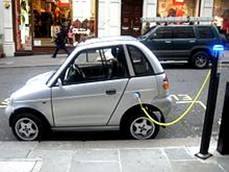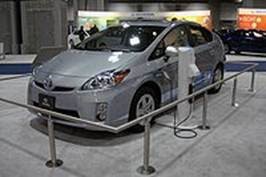Unit 3. Alternative Fuel Vehicle
I. Read the text and say why the development of cleaner alternative fuels and advanced power systems for vehicles is of great importance nowadays.
Alternative Fuel Vehicle
An alternative fuel vehicle is a vehicle that runs on a fuel other than "traditional" petroleum fuels (petrol or diesel); and also refers to any technology of powering an engine that does not involve only petroleum (e.g. electric car, hybrid electric vehicles, solar powered). Because of a combination of factors, such as environmental concerns and high oil prices the development of cleaner alternative fuels and advanced power systems for vehicles has become a high priority for many governments and vehicle manufacturers around the world.  As of early 2011 more than 43 million alternative fuel and advanced technology vehicles have been sold worldwide, compared to around 900 million cars and light trucks in use in the world in 2010.
As of early 2011 more than 43 million alternative fuel and advanced technology vehicles have been sold worldwide, compared to around 900 million cars and light trucks in use in the world in 2010.
II. Scan the text and name the main advantages of electric vehicles.
Electric Vehicle
An electric car is an automobile which is propelled by an electric motor, using electrical energy stored in batteries or another energy storage device. Electric cars were popular in the late-19th century and early 20th century, until advances in the internal combustion engine technology and the mass production of cheaper gasoline (petrol) vehicles led to a decline in the use of electric drive vehicle.
Despite their relatively slow speed, electric vehicles had a number of advantages over their early-1900s competitors. They did not have the vibration, smell, and noise associated with gasoline cars. They did not require gear changes, which for gasoline cars was the most difficult part of driving.
In the mid 2000s took place a renewed interest in the production of electric cars due mainly to concerns about rapidly increasing oil prices and the need to curb greenhouse gas emissions.
As of 2011 series production models available in some countries include the Tesla Roadster, Buddy, Mitsubishi and Nissan Leaf.
Notes:
decline, n. – спад
gasoline / petrol, n.–бензин
advantage, n. – преимущество
competitor, n. – конкурент
gear change, n.– переключение передач
curb, v. – сдерживать
propulsion system, n. – силовая установка
underpowered, adj. – недостаточной мощности
III. Read the text and answer the questions.
Hybrid Vehicle

A hybrid vehicle uses multiple propulsion systems to provide motive power. The most common type of a hybrid vehicle is the gasoline-electric hybrid vehicles, which use gasoline (petrol) and electric batteries for the energy used to power internal combustion engines (ICEs) and electric motors. These motors are usually relatively small and would be considered "underpowered" by themselves, but they can provide a normal driving experience when used in combination during acceleration and other maneuvers that require greater power.
The Toyota Prius first went on sale in Japan in 1997 and it has been sold worldwide since 2000. By 2010 the Prius was sold in more than 70 countries and regions, with Japan and the United States as its largest markets. In May 2008, global cumulative Prius sales reached the 1 million units, and by September 2010, the Prius reached worldwide cumulative sales of 2 million units.
Answer the following questions:
- What is an alternative fuel vehicle?
- What is an electric car propelled by?
- What advantages do electric cars have?
- Why did a renewed interest in the production of electric cars take place in the mid 2000s?
- What systems does a hybrid vehicle use?
- When can electric motors provide a normal driving experience?
- What car is the most popular hybrid car in the world?
IV. Translate the text, use the dictionary if necessary.
Flexible-Fuel Vehicle
A flexible-fuel vehicle (FFV) or a dual-fuel vehicle is an alternative fuel automobile or a light duty truck with a multi-fuel engine that can use more than one fuel, usually mixed in the same tank, and the blend is burned in the combustion chamber together. These vehicles are usually called flex-fuels, or flexi-fuels in Europe. FFVs are distinguished from bi-fuel vehicles, where two fuels are stored in separate tanks. The most common commercially available FFV in the world market is the ethanol flexible-fuel vehicle, with the major markets concentrated in the United States, Brazil, Sweden, and some other European countries.
In addition to flex-fuel vehicles running with ethanol, in the US and Europe there were successful test programs with methanol flex-fuel vehicles, known as M85 FFVs, and more recently there have been also successful tests using p-series fuels with E85 flex fuel vehicles, but this fuel is not yet available to the general public.
Notes:
facilitate, v. – содействовать
define, v. – определять
prohibitive, adj. – запрещающий
compulsory, adj.– обязательный
legal offence, n. – нарушение закона
warning signs, n.– предупреждающие знаки
Morozova О.N., Ilina I.Y.Тамбов2015